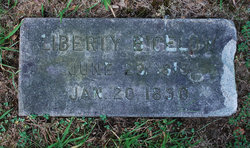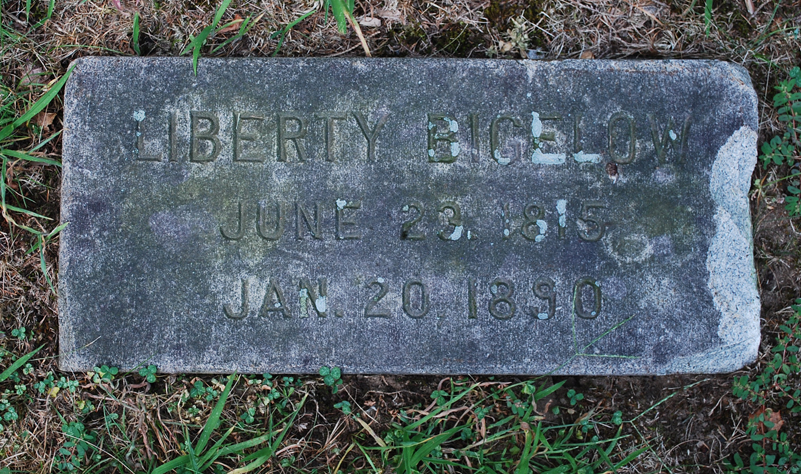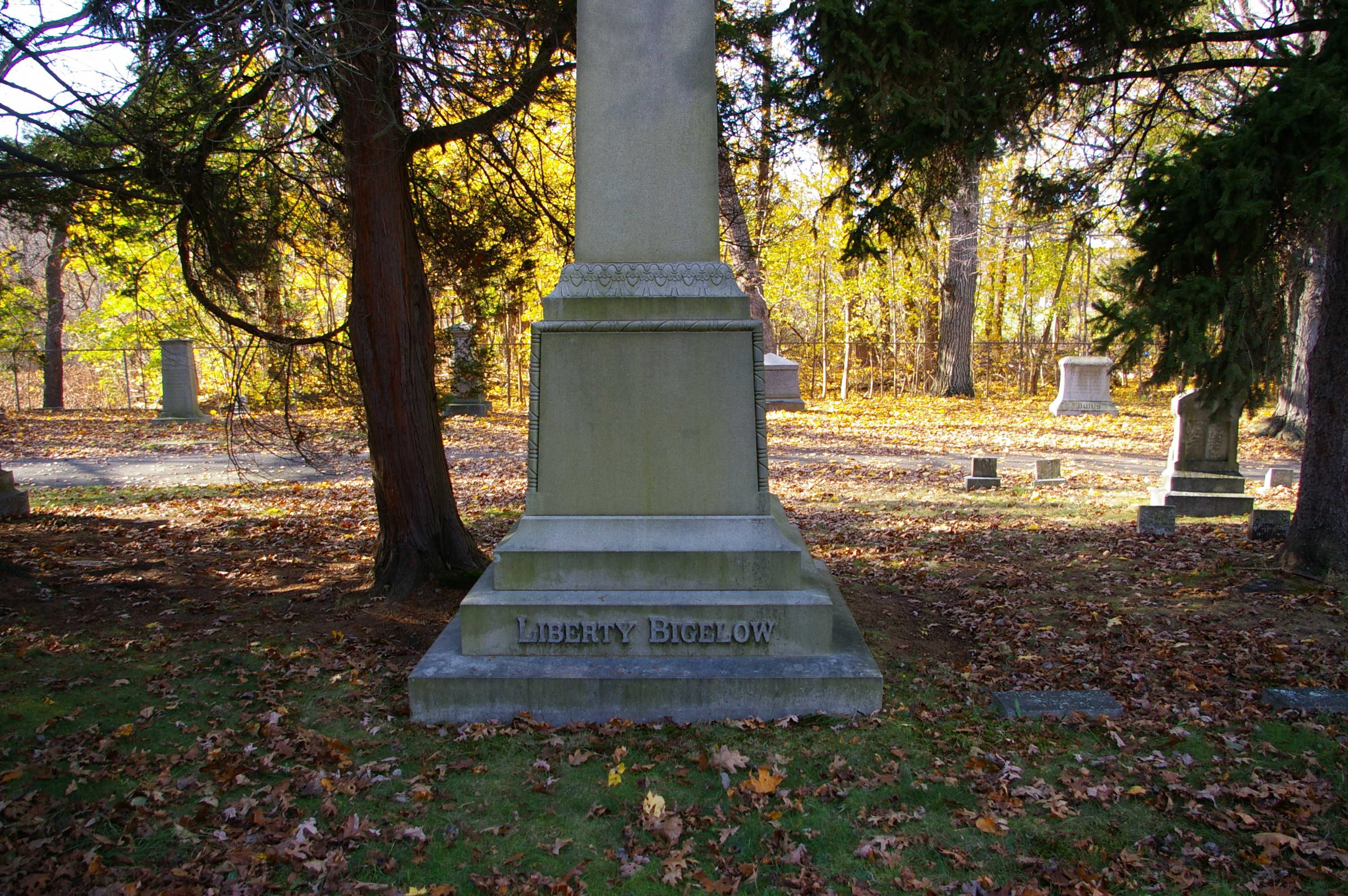Liberty, born in Sutton, June 23, 1815; married March 31, 1835, Harriet A. Lawrence of Groton; at the age of seventeen he left home, started in life as a stage-driver, and soon after became proprietor of a stage line between Fitchburg and Keene. In 1844 established the fastest pony express (between Boston and New York) ever known before the days of railroads, and carried the U. S. mails. When the railroad was put through between Rutland and Bellows Falls, Vt., he was appointed the first superintendent. In 1854 he was appointed superintendent of the Fitchburg R. R., and resigned in 1857 to commence the express business between Fitchburg and Boston, and later the business was consolidated with others, and formed the U. S. and Canada Express Co, After this he went to Chicago and started a line of city coaches, and later he became interested in the first horse railroad in Chicago. After a few years' residence in that city he returned to Massachusetts and resided in Melrose, where he lived a retired life. He was of a modest, retiring nature and of genial disposition. He died at Melrose, Jan. 20, 1890, aged 74 years. He left a widow." Source: Genealogy of the Bigelow family of America: from the marriage on 1642 of John Bigelow and Mary Warren to the year 1890. Gilman Bigelow Howe, page 195.
Beebe Estate:......."Around 1842 William Harlow, also a Boston businessman, purchased the Foster estate on West Foster Street, Melrose, from Mr. Foster. Mr. Harlow was connected with the steam railroad business, and while he was living in the house the Boston & Maine railroad tracks were laid through Melrose in 1845, a portion adjoining his land. He remained in the house for 12 years, and then sold it to Liberty Bigelow
Mr. Bigelow, who was born in Sutton, Massachusetts, on June 23, 1815, left home at the early age of 17 to seek his fortune. He became a stage driver, then considered a respectable calling, and made a real success of it. After consulting with James Gordon Bennett, the noted Scottish-American newspaper publisher and journalist, he established the first stage express between Boston and New York.
When steam railroads began to replace stage express, Mr. Bigelow naturally gravitated to the railroad business. It was his idea that the Cheshire Railroad, based in Keene, New Hampshire, then in its infancy, should be extended into Vermont. He was able to attract the attention of the proper people with his idea and when the Sullivan and the Rutland Railroad lines were established in Vermont, he was appointed Superintendent.
In 1854, Liberty Bigelow was appointed Superintendent of the much larger Fitchburg Railroad with offices in Boston. At about this time he purchased the Melrose home built by William Foster. Bigelow left the Fitchburg Railroad in 1857 to establish his own express business in Brattle Square, Boston. His company first expressed merchandise by railroad between Fitchburg, Massachusetts, and Keene, New Hampshire. Later he merged his company with Northern Express Ltd. There was born his idea for a United States - Canadian express, which developed into one of the most prosperous express companies on the continent.
A few years later, Mr. Bigelow was asked to go to Chicago to work with Franklin Parmalee in establishing a horse street railway system. New York City had had such a system for some years and many of the large eastern cities had followed suit. Chicago having become a thriving city, was in great need of such a method of transportation. The Chicago City Railway Company founded by Bigelow and Parmalee was a great success. Liberty Bigelow first conceived the idea of running a system of railway coaches between railroad stations and hotels in Chicago. This idea spread throughout the eastern part of the country. During his stay in Chicago, the Bigelow family remained in their Melrose home. After completing his service of about five years in Chicago, he returned to Melrose to enjoy a well deserved retirement. He continued to serve as director of several Boston concerns including the Metropolitan Horse Railway.
Mr. Bigelow died in Melrose on June 20, 1890, in his 75th year. He was described as a fine physical specimen, modest and retiring, genial and philanthropically minded; beloved and respected by all.
The estate remained in the hands of Liberty Bigelow's widow, Harriet A. Bigelow. In this house, the Melrose Hospital Association was organized on July 28, 1893. Mrs. Bigelow was a strong supporter of the hospital and gave much of her time and money to it. From this beginning, the hospital has grown into the large private institution that it is today.
At Mrs. Bigelow's death in 1898, her daughter, Katherine, inherited the estate. She was married to Decius Beebe, descendent of a wealthy family and a member of the firm of Lucius Beebe and Sons of Boston, which had extensive interests and tanneries in New England." Source: The Beebe Estate by Arnold W. Williams
"The Beebe Estate is the finest Greek Revival-style mansion in Melrose. Its elegant cupola and elaborate balustrade have graced West Foster Street for more than one hundred and seventy years. It was built in 1828 by internationally prominent merchant, William Foster, as his summer retreat.
In 1854 it was purchased by Liberty Bigelow, and his wife, Harriet, both important Melrose philanthropists.
In 1898 the estate was inherited by the Bigelow's adopted daughter, Katherine, and her husband, leather manufacturer Decius Beebe. Members of the Beebe family occupied the house until 1963, when it was acquired by the City of Melrose.
Contributor: steve s (47126287
Liberty, born in Sutton, June 23, 1815; married March 31, 1835, Harriet A. Lawrence of Groton; at the age of seventeen he left home, started in life as a stage-driver, and soon after became proprietor of a stage line between Fitchburg and Keene. In 1844 established the fastest pony express (between Boston and New York) ever known before the days of railroads, and carried the U. S. mails. When the railroad was put through between Rutland and Bellows Falls, Vt., he was appointed the first superintendent. In 1854 he was appointed superintendent of the Fitchburg R. R., and resigned in 1857 to commence the express business between Fitchburg and Boston, and later the business was consolidated with others, and formed the U. S. and Canada Express Co, After this he went to Chicago and started a line of city coaches, and later he became interested in the first horse railroad in Chicago. After a few years' residence in that city he returned to Massachusetts and resided in Melrose, where he lived a retired life. He was of a modest, retiring nature and of genial disposition. He died at Melrose, Jan. 20, 1890, aged 74 years. He left a widow." Source: Genealogy of the Bigelow family of America: from the marriage on 1642 of John Bigelow and Mary Warren to the year 1890. Gilman Bigelow Howe, page 195.
Beebe Estate:......."Around 1842 William Harlow, also a Boston businessman, purchased the Foster estate on West Foster Street, Melrose, from Mr. Foster. Mr. Harlow was connected with the steam railroad business, and while he was living in the house the Boston & Maine railroad tracks were laid through Melrose in 1845, a portion adjoining his land. He remained in the house for 12 years, and then sold it to Liberty Bigelow
Mr. Bigelow, who was born in Sutton, Massachusetts, on June 23, 1815, left home at the early age of 17 to seek his fortune. He became a stage driver, then considered a respectable calling, and made a real success of it. After consulting with James Gordon Bennett, the noted Scottish-American newspaper publisher and journalist, he established the first stage express between Boston and New York.
When steam railroads began to replace stage express, Mr. Bigelow naturally gravitated to the railroad business. It was his idea that the Cheshire Railroad, based in Keene, New Hampshire, then in its infancy, should be extended into Vermont. He was able to attract the attention of the proper people with his idea and when the Sullivan and the Rutland Railroad lines were established in Vermont, he was appointed Superintendent.
In 1854, Liberty Bigelow was appointed Superintendent of the much larger Fitchburg Railroad with offices in Boston. At about this time he purchased the Melrose home built by William Foster. Bigelow left the Fitchburg Railroad in 1857 to establish his own express business in Brattle Square, Boston. His company first expressed merchandise by railroad between Fitchburg, Massachusetts, and Keene, New Hampshire. Later he merged his company with Northern Express Ltd. There was born his idea for a United States - Canadian express, which developed into one of the most prosperous express companies on the continent.
A few years later, Mr. Bigelow was asked to go to Chicago to work with Franklin Parmalee in establishing a horse street railway system. New York City had had such a system for some years and many of the large eastern cities had followed suit. Chicago having become a thriving city, was in great need of such a method of transportation. The Chicago City Railway Company founded by Bigelow and Parmalee was a great success. Liberty Bigelow first conceived the idea of running a system of railway coaches between railroad stations and hotels in Chicago. This idea spread throughout the eastern part of the country. During his stay in Chicago, the Bigelow family remained in their Melrose home. After completing his service of about five years in Chicago, he returned to Melrose to enjoy a well deserved retirement. He continued to serve as director of several Boston concerns including the Metropolitan Horse Railway.
Mr. Bigelow died in Melrose on June 20, 1890, in his 75th year. He was described as a fine physical specimen, modest and retiring, genial and philanthropically minded; beloved and respected by all.
The estate remained in the hands of Liberty Bigelow's widow, Harriet A. Bigelow. In this house, the Melrose Hospital Association was organized on July 28, 1893. Mrs. Bigelow was a strong supporter of the hospital and gave much of her time and money to it. From this beginning, the hospital has grown into the large private institution that it is today.
At Mrs. Bigelow's death in 1898, her daughter, Katherine, inherited the estate. She was married to Decius Beebe, descendent of a wealthy family and a member of the firm of Lucius Beebe and Sons of Boston, which had extensive interests and tanneries in New England." Source: The Beebe Estate by Arnold W. Williams
"The Beebe Estate is the finest Greek Revival-style mansion in Melrose. Its elegant cupola and elaborate balustrade have graced West Foster Street for more than one hundred and seventy years. It was built in 1828 by internationally prominent merchant, William Foster, as his summer retreat.
In 1854 it was purchased by Liberty Bigelow, and his wife, Harriet, both important Melrose philanthropists.
In 1898 the estate was inherited by the Bigelow's adopted daughter, Katherine, and her husband, leather manufacturer Decius Beebe. Members of the Beebe family occupied the house until 1963, when it was acquired by the City of Melrose.
Contributor: steve s (47126287
Family Members
Advertisement
Explore more
Sponsored by Ancestry
Advertisement












